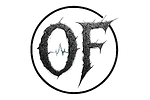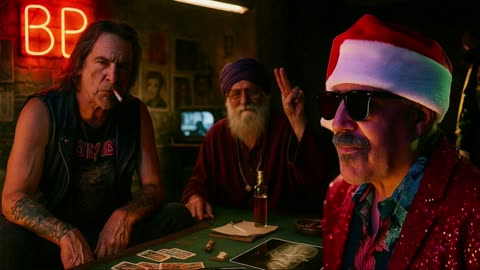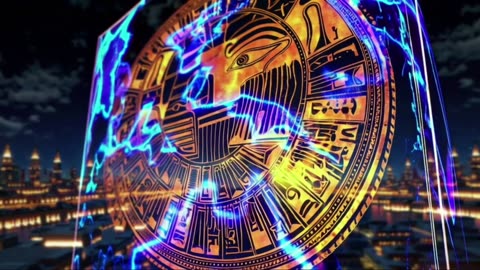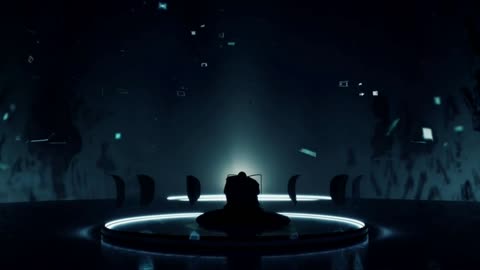
Oblivion Frequency: The Broadcasts
38 videos
Updated 28 days ago
Oblivion Frequency is not entertainment in the usual sense—it is a transmission. A broadcast from the edges of thought, where philosophy, science fiction, and raw human experience collide. Within this playlist you’ll find every episode gathered in one continuous flow, an archive of voices and visions speaking through static. These are transmissions of mind and spirit, sometimes unsettling, sometimes luminous, always resonant.
To watch Oblivion Frequency is to tune in to a signal that runs deeper than culture, deeper than politics, deeper than noise. It is a reminder that even in the chaos of the world, there is pattern, there is meaning, there is frequency—and it can be heard.
-
The Ancients Knew: Simulation Theory, Egyptian Star Roads, and Greek Mathematics
 ScienceFictionAuthorDColinPalmerTonight’s episode is a guided monologue through the oldest “operating systems” of the human mind—ancient beliefs that weren’t just superstition, but frameworks for reality that still echo inside modern ideas like Simulation Theory and multidimensional physics. We begin with a wide-angle look at ancient cosmologies and why early civilizations were so concerned with order, fate, cycles, and “the unseen architecture” behind the world of appearances. Then we go deeper into Ancient Egypt: spiritual technology, the ka and ba, the afterlife as a navigable geography, and the strange, enduring idea that consciousness might move across layers of reality like a traveler following a hidden set of routes. From there, we cross the Mediterranean into Ancient Greece—where number becomes sacred, geometry becomes a language for the universe, and math stops being a tool and starts acting like a clue. Finally, we bring it all together: Greek metaphysics and early “simulation-like” thinking, the relationship between mind and cosmos, and why the modern Matrix question—“what is reality made of?”—is not new at all. It’s ancient. It’s recurring. And it may be the most human question we’ve ever asked.128 views
ScienceFictionAuthorDColinPalmerTonight’s episode is a guided monologue through the oldest “operating systems” of the human mind—ancient beliefs that weren’t just superstition, but frameworks for reality that still echo inside modern ideas like Simulation Theory and multidimensional physics. We begin with a wide-angle look at ancient cosmologies and why early civilizations were so concerned with order, fate, cycles, and “the unseen architecture” behind the world of appearances. Then we go deeper into Ancient Egypt: spiritual technology, the ka and ba, the afterlife as a navigable geography, and the strange, enduring idea that consciousness might move across layers of reality like a traveler following a hidden set of routes. From there, we cross the Mediterranean into Ancient Greece—where number becomes sacred, geometry becomes a language for the universe, and math stops being a tool and starts acting like a clue. Finally, we bring it all together: Greek metaphysics and early “simulation-like” thinking, the relationship between mind and cosmos, and why the modern Matrix question—“what is reality made of?”—is not new at all. It’s ancient. It’s recurring. And it may be the most human question we’ve ever asked.128 views -
THE GATE SEQUENCE — Four Monologues from the Edge of Thought
 ScienceFictionAuthorDColinPalmerThis episode includes four serious philosophical transmissions—spoken in clear, poetic, intellectually rigorous language. Each monologue investigates the tension between mythology, logic, identity, and the hidden systems shaping our world. These are not poems, not political rants, and not musical tracks. They are standalone meditations—designed for reflection, discussion, and serious thought. Included Monologues: The Archons on the Couch A psychological and symbolic investigation of what evil looks like when it enters through ambiguity. Discusses the shadow, contradiction, euphemism, and the “enemy within.” Opening of the Mouth, Closing of the Gate A dive into Egyptian metaphysics, border rituals, the Duat, and the idea of coherence as moral responsibility. Describes ancient ceremony as anti-malware code for the soul. New Fire at Simulation’s Edge A high-concept meditation on reality as layered software, ritual as source code, and fire as the recompiler of identity. Discusses Aztec tradition, simulation theory, and psychological reintegration. The Mirror of Origin A final poetic reflection on personal identity, deep memory, and ancestral return. Time collapses, and the speaker recalls the original wound, the original promise, and the first symbol that ever held meaning. Content Note: This is not for children, not for meme culture, not for casual consumption. These monologues are meant to be listened to in solitude or silence—with full attention. They are part lecture, part ritual. No music. Just voice, idea, and intensity.106 views 1 comment
ScienceFictionAuthorDColinPalmerThis episode includes four serious philosophical transmissions—spoken in clear, poetic, intellectually rigorous language. Each monologue investigates the tension between mythology, logic, identity, and the hidden systems shaping our world. These are not poems, not political rants, and not musical tracks. They are standalone meditations—designed for reflection, discussion, and serious thought. Included Monologues: The Archons on the Couch A psychological and symbolic investigation of what evil looks like when it enters through ambiguity. Discusses the shadow, contradiction, euphemism, and the “enemy within.” Opening of the Mouth, Closing of the Gate A dive into Egyptian metaphysics, border rituals, the Duat, and the idea of coherence as moral responsibility. Describes ancient ceremony as anti-malware code for the soul. New Fire at Simulation’s Edge A high-concept meditation on reality as layered software, ritual as source code, and fire as the recompiler of identity. Discusses Aztec tradition, simulation theory, and psychological reintegration. The Mirror of Origin A final poetic reflection on personal identity, deep memory, and ancestral return. Time collapses, and the speaker recalls the original wound, the original promise, and the first symbol that ever held meaning. Content Note: This is not for children, not for meme culture, not for casual consumption. These monologues are meant to be listened to in solitude or silence—with full attention. They are part lecture, part ritual. No music. Just voice, idea, and intensity.106 views 1 comment -
The God Particle and the Empty Field: Quantum Tao of the Universe
 Cryptic Cosmos – Exploring Aliens, Anomalies, and Apocalypse SoundsIn this two-part exploration, science meets mysticism at the edge of reality. The God Particle and the Empty Field dives deep into the Higgs Boson — the elusive ripple that gives mass to all matter — and unfolds it through the languages of quantum mechanics, Buddhist philosophy, and Taoist harmony. From symmetry breaking to shunyata, from spontaneous order to wu wei, this episode bridges the Standard Model and spiritual insight, revealing how the universe may be both perfectly scientific and profoundly sacred. Join Science Fiction Author D. Colin Palmer as physics becomes poetry, and enlightenment meets the Higgs field.125 views 2 comments
Cryptic Cosmos – Exploring Aliens, Anomalies, and Apocalypse SoundsIn this two-part exploration, science meets mysticism at the edge of reality. The God Particle and the Empty Field dives deep into the Higgs Boson — the elusive ripple that gives mass to all matter — and unfolds it through the languages of quantum mechanics, Buddhist philosophy, and Taoist harmony. From symmetry breaking to shunyata, from spontaneous order to wu wei, this episode bridges the Standard Model and spiritual insight, revealing how the universe may be both perfectly scientific and profoundly sacred. Join Science Fiction Author D. Colin Palmer as physics becomes poetry, and enlightenment meets the Higgs field.125 views 2 comments -
The Quantum Monk at the Final Table — Thoughts on Poker, Faith, and the Nature of Reality
 ScienceFictionAuthorDColinPalmerScience Fiction Author D. Colin Palmer returns with a far‑out meditation on poker theory, consciousness, and the strange symmetry between mathematics and mysticism. In this episode, he explores how Game Theory Optimal play becomes a kind of modern Zen—where Buddhism’s detachment, Quantum Mechanics’ uncertainty, and Nietzsche’s will‑to‑power merge into one disciplined philosophy of competition. It’s not just about winning hands; it’s about understanding the waveform of existence itself. A reflection on stillness, strategy, and what it means to face the infinite with a chip stack and a calm heart.114 views 1 comment
ScienceFictionAuthorDColinPalmerScience Fiction Author D. Colin Palmer returns with a far‑out meditation on poker theory, consciousness, and the strange symmetry between mathematics and mysticism. In this episode, he explores how Game Theory Optimal play becomes a kind of modern Zen—where Buddhism’s detachment, Quantum Mechanics’ uncertainty, and Nietzsche’s will‑to‑power merge into one disciplined philosophy of competition. It’s not just about winning hands; it’s about understanding the waveform of existence itself. A reflection on stillness, strategy, and what it means to face the infinite with a chip stack and a calm heart.114 views 1 comment -
The Divine Substrate: Why You Are Worthy of Love and God Is Not Somewhere Else
 ScienceFictionAuthorDColinPalmerScience Fiction Author D. Colin Palmer returns with the finale of his philosophical monologue series, exploring the deepest questions of existence: What is God? What are we? And are we worthy of love in a universe governed by entropy, quantum collapse, and the illusion of separation? Drawing from Buddhist philosophy, quantum mechanics, Nietzschean courage, and theoretical physics, this episode culminates in a single, undeniable truth: you are not an accident—you are the divine remembering itself. This is not religion. This is not sentiment. This is metaphysical architecture—the scaffolding of being laid bare. If you have ever felt broken, small, or unloved in a collapsing world, this message is for you. You are worthy of love. And everything that told you otherwise is a lie.101 views 1 comment
ScienceFictionAuthorDColinPalmerScience Fiction Author D. Colin Palmer returns with the finale of his philosophical monologue series, exploring the deepest questions of existence: What is God? What are we? And are we worthy of love in a universe governed by entropy, quantum collapse, and the illusion of separation? Drawing from Buddhist philosophy, quantum mechanics, Nietzschean courage, and theoretical physics, this episode culminates in a single, undeniable truth: you are not an accident—you are the divine remembering itself. This is not religion. This is not sentiment. This is metaphysical architecture—the scaffolding of being laid bare. If you have ever felt broken, small, or unloved in a collapsing world, this message is for you. You are worthy of love. And everything that told you otherwise is a lie.101 views 1 comment -
The Multiverse Is a Poker Table: Gambling, Quantum Reality, and the Soul
 ScienceFictionAuthorDColinPalmerThis intense philosophical monologue journeys across quantum physics, Egyptian mysticism, Machiavellian power dynamics, and chaos theory to explore a startling insight: gambling isn’t just luck—it’s cosmic authorship. Every wager collapses a wave of possibility, forging a new reality where fate, will, and risk converge into fractal creation. This immersive piece explores: Quantum entanglement and the collapse of potential into lived outcome Machiavelli’s Fortuna as a philosophy of strategic chaos Egyptian metaphysics of the Ka, Ba, Duat, and Ma’at as soul mechanics Chaos theory, string vibration, and fractal recursion embedded in risk The observer’s role in shaping reality by witnessing If you’ve ever felt the silence before a card flips... or the chill of fate deciding… this monologue exists within you already. Reality is a game. And the gambler is not merely a player—but the author of the next world.134 views
ScienceFictionAuthorDColinPalmerThis intense philosophical monologue journeys across quantum physics, Egyptian mysticism, Machiavellian power dynamics, and chaos theory to explore a startling insight: gambling isn’t just luck—it’s cosmic authorship. Every wager collapses a wave of possibility, forging a new reality where fate, will, and risk converge into fractal creation. This immersive piece explores: Quantum entanglement and the collapse of potential into lived outcome Machiavelli’s Fortuna as a philosophy of strategic chaos Egyptian metaphysics of the Ka, Ba, Duat, and Ma’at as soul mechanics Chaos theory, string vibration, and fractal recursion embedded in risk The observer’s role in shaping reality by witnessing If you’ve ever felt the silence before a card flips... or the chill of fate deciding… this monologue exists within you already. Reality is a game. And the gambler is not merely a player—but the author of the next world.134 views -
Parapsychology Ghost Tale & Ancient Egyptian Interdimensional Secrets
 ScienceFictionAuthorDColinPalmerA special double feature exploring mysteries both modern and ancient. First, we journey into parapsychology and a ghost tale from Saint John, New Brunswick, uncovering strange encounters and the timeless fascination with the paranormal. Then, we travel back thousands of years to examine Ancient Egyptian religious texts that may hint at the mysteries of interdimensional travel. From ghostly whispers to cosmic gateways, this feature connects folklore, spirituality, and the unknown into one unforgettable exploration.96 views 2 comments
ScienceFictionAuthorDColinPalmerA special double feature exploring mysteries both modern and ancient. First, we journey into parapsychology and a ghost tale from Saint John, New Brunswick, uncovering strange encounters and the timeless fascination with the paranormal. Then, we travel back thousands of years to examine Ancient Egyptian religious texts that may hint at the mysteries of interdimensional travel. From ghostly whispers to cosmic gateways, this feature connects folklore, spirituality, and the unknown into one unforgettable exploration.96 views 2 comments -
Simulated Samsara: Buddhism, Jung & Vonnegut on Why Tech Feels Like a Script
 ScienceFictionAuthorDColinPalmerWhat happens when our brains can’t keep up with our machines? This monologue argues that we’re living inside a curated loop—samsara with a silicon spine—where algorithms farm attention, nudge choice, and script our days. We move from Buddhist insights on suffering, no-self, and the Middle Way to Freud’s ego under siege, regression-by-design, and our Oedipal rebellion against AI. Jung’s archetypes reappear as feed mechanics—the Shadow in the black box, the Trickster in memes—while sociology maps the aquarium: stratified classes, echo chambers, deskilled lives, and moderators who can rewrite the rules mid-game. Economics explains the profit of confusion: depreciating human capital, nudges that look like choices, dazzling interfaces masking real stagnation. Then Vonnegut winks from the control room—“So it goes”—as time plays like save files and foma keeps the cursor moving. The exit instructions are simple and hard: treat mindfulness as latency detection, reclaim your Shadow, build offline craft, and hold long-form conversations no algorithm can compress. Are we becoming slaves to our own tech—or players who remember we’re in a game? Don’t let your mind atrophy—read, think, resist the algorithm. If this hit you, drop a comment, share it with someone who needs the wake-up, and subscribe for more uncompromising, long-form truth.104 views
ScienceFictionAuthorDColinPalmerWhat happens when our brains can’t keep up with our machines? This monologue argues that we’re living inside a curated loop—samsara with a silicon spine—where algorithms farm attention, nudge choice, and script our days. We move from Buddhist insights on suffering, no-self, and the Middle Way to Freud’s ego under siege, regression-by-design, and our Oedipal rebellion against AI. Jung’s archetypes reappear as feed mechanics—the Shadow in the black box, the Trickster in memes—while sociology maps the aquarium: stratified classes, echo chambers, deskilled lives, and moderators who can rewrite the rules mid-game. Economics explains the profit of confusion: depreciating human capital, nudges that look like choices, dazzling interfaces masking real stagnation. Then Vonnegut winks from the control room—“So it goes”—as time plays like save files and foma keeps the cursor moving. The exit instructions are simple and hard: treat mindfulness as latency detection, reclaim your Shadow, build offline craft, and hold long-form conversations no algorithm can compress. Are we becoming slaves to our own tech—or players who remember we’re in a game? Don’t let your mind atrophy—read, think, resist the algorithm. If this hit you, drop a comment, share it with someone who needs the wake-up, and subscribe for more uncompromising, long-form truth.104 views -
WEF Great Reset EXPOSED: CBDCs, Digital IDs & The Mark of Control
 ScienceFictionAuthorDColinPalmerWhat if the WEF’s “Great Reset” isn’t salvation—but soft control? This high-energy monologue connects quantum mechanics, theoretical physics, Buddhism, Revelation, and even Nostradamus to examine a technocratic future built on pandemics, programmable money (CBDCs), digital IDs, and social credit. We break down how crises expand state power (Keynes), why programmable currencies risk economic servitude (Friedman), how central planning distorts freedom (Hayek), and how surveillance capitalism monetizes obedience. History’s warnings—from Rome’s bread & circuses to Weimar’s currency convulsions—meet Foucault’s panopticon, Nietzsche’s slave morality, Marx’s false consciousness, Arendt’s totalitarianism, and Locke’s consent. Revelation’s “mark” to buy or sell feels less symbolic when a central ledger can switch you off. Who measures you, owns you. Don’t trade sovereignty for sedation. Read, think, build offline skills, and ask the only questions that matter: Who programs your wallet? Who sets your score? Who audits the auditors? If this hit you, comment, share, and subscribe.128 views 1 comment
ScienceFictionAuthorDColinPalmerWhat if the WEF’s “Great Reset” isn’t salvation—but soft control? This high-energy monologue connects quantum mechanics, theoretical physics, Buddhism, Revelation, and even Nostradamus to examine a technocratic future built on pandemics, programmable money (CBDCs), digital IDs, and social credit. We break down how crises expand state power (Keynes), why programmable currencies risk economic servitude (Friedman), how central planning distorts freedom (Hayek), and how surveillance capitalism monetizes obedience. History’s warnings—from Rome’s bread & circuses to Weimar’s currency convulsions—meet Foucault’s panopticon, Nietzsche’s slave morality, Marx’s false consciousness, Arendt’s totalitarianism, and Locke’s consent. Revelation’s “mark” to buy or sell feels less symbolic when a central ledger can switch you off. Who measures you, owns you. Don’t trade sovereignty for sedation. Read, think, build offline skills, and ask the only questions that matter: Who programs your wallet? Who sets your score? Who audits the auditors? If this hit you, comment, share, and subscribe.128 views 1 comment -
Render at the Point of Gaze — Five Proofs We Live in Code
 ScienceFictionAuthorDColinPalmerScience Fiction Author D. Colin Palmer dives deep into simulation theory with five interconnected arguments that read like a blueprint of our universe’s hidden engine. We start where measurement cuts—quantum indeterminacy as lazy evaluation and entanglement as a shared database key—then move to holographic compression, Planck-scale discreteness, and the uncanny fine-tuning of cosmic parameters. From there, we reframe Sumerian cosmology as a memory of stacked authorship and nested worlds, before treating cosmic expansion, black holes, and error-correcting horizons as system-level optimization. Finally, consciousness appears as the interpreter that renders reality at the cursor of attention, turning ethics into ergonomics for souls. If the cosmos isn’t code, it is its perfect metaphor—operationally indistinguishable from truth. Watch, think, and then debug your life accordingly. Hit that subscribe.97 views
ScienceFictionAuthorDColinPalmerScience Fiction Author D. Colin Palmer dives deep into simulation theory with five interconnected arguments that read like a blueprint of our universe’s hidden engine. We start where measurement cuts—quantum indeterminacy as lazy evaluation and entanglement as a shared database key—then move to holographic compression, Planck-scale discreteness, and the uncanny fine-tuning of cosmic parameters. From there, we reframe Sumerian cosmology as a memory of stacked authorship and nested worlds, before treating cosmic expansion, black holes, and error-correcting horizons as system-level optimization. Finally, consciousness appears as the interpreter that renders reality at the cursor of attention, turning ethics into ergonomics for souls. If the cosmos isn’t code, it is its perfect metaphor—operationally indistinguishable from truth. Watch, think, and then debug your life accordingly. Hit that subscribe.97 views








